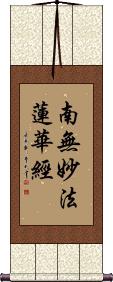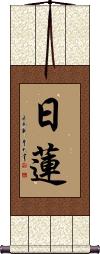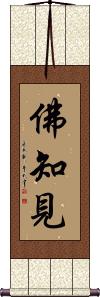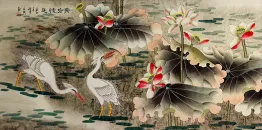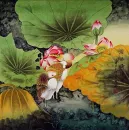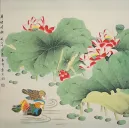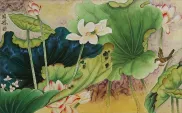Many custom options...
And formats...

Lotus Sutra in Chinese / Japanese...
Buy a Lotus Sutra calligraphy wall scroll here!
Personalize your custom “Lotus Sutra” project by clicking the button next to your favorite “Lotus Sutra” title below...
Namu Myoho Renge Kyo / Homage to Lotus Sutra
南無妙法蓮華經 is sometimes translated as the “Devotion to the Law of the Lotus Flower Scripture.”
This is a meditation chant and homage to the Lotus Sutra, used by Nichiren Buddhists in Japan.
This is also a chant used in China by certain sects of Buddhism that celebrate the deity Guanyin.
Also romanized as “Nam Myōhō Renge Kyō” or without accents as “Nam Myoho Renge Kyo.”
Original
Traditional
Version
The last character was originally written as seen on the left. Sometimes, you will see it written in the Japanese variant form as shown on the right. If you want this Japanese variant, click on the "Modern Japanese Variant" text instead of the button up by the main title of this entry.
Nichiren
日蓮 is the title Nichiren.
This title refers to a Buddhist priest who lived from 1222 to 1282. He is the founder of the Nichiren sect of Buddhism.
According to historical documents, the Nichiren sect was established in 1252. Adding the character 宗 for sect, this would be 日蓮宗 (Nichiren sect), which is also known as the 法華宗 or Lotus sect.
According to Soothill-Hodous...
Nichiren's chief tenets are the three great mysteries 三大祕法, representing the trikāya:
1. 本尊 or chief object of worship, being the great maṇḍala of the worlds of the ten directions, or universe, i.e., the body or nirmāṇakāya of Buddha.
2. 題目 the title of the Lotus Sutra 妙法蓮華經 Myo-ho-ren-ge-kyo, preceded by Namo, or “Adoration to the scripture of the lotus of the wonderful law,” for it is Buddha's spiritual body.
3. 戒壇 the altar of the law, which is also the title of the Lotus as above; the believer, wherever he is, dwells in the Pure-land of calm light 寂光淨土, the saṃbhogakāya.
Wisdom and Insight of the Buddha
This in-stock artwork might be what you are looking for, and ships right away...
Gallery Price: $108.00
Your Price: $59.88
Gallery Price: $340.00
Your Price: $188.88
Gallery Price: $304.00
Your Price: $168.88
Gallery Price: $60.00
Your Price: $36.88
Gallery Price: $126.00
Your Price: $69.88
Gallery Price: $60.00
Your Price: $36.88
Gallery Price: $90.00
Your Price: $49.88
Gallery Price: $300.00
Your Price: $128.88
Gallery Price: $60.00
Your Price: $36.88
Gallery Price: $353.00
Your Price: $195.88
Gallery Price: $353.00
Your Price: $195.88
Gallery Price: $353.00
Your Price: $195.88
Not the results for lotus sutra that you were looking for?
Below are some entries from our dictionary that may match your lotus sutra search...
| Characters If shown, 2nd row is Simp. Chinese |
Pronunciation Romanization |
Simple Dictionary Definition |
佛 see styles |
fú fu2 fu hotoke ほとけ |
More info & calligraphy: Buddhism / Buddha(surname) Hotoke Buddha, from budh to "be aware of", "conceive", "observe", "wake"; also 佛陀; 浮圖; 浮陀; 浮頭; 浮塔; 勃陀; 勃馱; 沒馱; 母馱; 母陀; 部陀; 休屠. Buddha means "completely conscious, enlightened", and came to mean the enlightener. he Chinese translation is 覺 to perceive, aware, awake; and 智 gnosis, knowledge. There is an Eternal Buddha, see e.g. the Lotus Sutra, cap. 16, and multitudes of Buddhas, but the personality of a Supreme Buddha, an Ādi-Buddha, is not defined. Buddha is in and through all things, and some schools are definitely Pan-Buddhist in the pantheistic sense. In the triratna 三寳 commonly known as 三寳佛, while Śākyamuni Buddha is the first "person" of the Trinity, his Law the second, and the Order the third, all three by some are accounted as manifestations of the All-Buddha. As Śākyamuni, the title indicates him as the last of the line of Buddhas who have appeared in this world, Maitreya is to be the next. As such he is the one who has achieved enlightenment, having discovered the essential evil of existence (some say mundane existence, others all existence), and the way of deliverance from the constant round of reincarnations; this way is through the moral life into nirvana, by means of self-abnegation, the monastic life, and meditation. By this method a Buddha, or enlightened one, himself obtains Supreme Enlightenment, or Omniscience, and according to Māhāyanism leads all beings into the same enlightenment. He sees things not as they seem in their phenomenal but in their noumenal aspects, as they really are. The term is also applied to those who understand the chain of causality (twelve nidānas) and have attained enlightenment surpassing that of the arhat. Four types of the Buddha are referred to: (1) 三藏佛the Buddha of the Tripiṭaka who attained enlightenment on the bare ground under the bodhi-tree; (2) 通佛the Buddha on the deva robe under the bodhi-tree of the seven precious things; (3) 別佛the Buddha on the great precious Lotus throne under the Lotus realm bodhi-tree; and (4) 圓佛the Buddha on the throne of Space in the realm of eternal rest and glory where he is Vairocana. The Hīnayāna only admits the existence of one Buddha at a time; Mahāyāna claims the existence of many Buddhas at one and the same time, as many Buddhas as there are Buddha-universes, which are infinite in number. |
日蓮 日莲 see styles |
rì lián ri4 lian2 jih lien nichiren にちれん |
More info & calligraphy: NichirenNichiren, the Japanese founder, in A. D. 1252, of the 日蓮宗 Nichiren sect, which is also known as the 法華宗 or Lotus sect. Its chief tenets are the three great mysteries 三大祕法, representing the trikāya: (1) 本尊 or chief object of worship, being the great maṇḍala of the worlds of the ten directions, or universe, i. e. the body or nirmāṇakāya of Buddha; (2) 題目 the title of the Lotus Sutra 妙法蓮華經 Myo-ho-ren-gwe-kyo, preceded by Namo, or, 'Adoration to the scripture of the lotus of the wonderful law, ' for it is Buddha's spiritual body; (3) 戒壇 the altar of the law, which is also the title of the Lotus as above; the believer, wherever he is, dwells in the Pure-land of calm light 寂光淨土, the saṃbhogakāya. |
觀世音 观世音 see styles |
guān shì yīn guan1 shi4 yin1 kuan shih yin Kanzeon かんぜおん |
More info & calligraphy: Guan Shi Yin: Protector Of Life(out-dated kanji) Avalokiteshvara (Bodhisattva); Avalokitesvara; Kannon; Kwannon; Guanyin; Buddhist deity of compassion Regarder of the world's sounds, or cries, the so-called Goddess of Mercy; also known as 觀音; 觀世音善薩; 觀自在 (觀世自在); 觀尹; 光世音 (the last being the older form). Avalokiteśvara, v. 阿 8. Originally represented as a male, the images are now generally those of a female figure. The meaning of the term is in doubt; it is intp. as above, but the term 觀自在 (觀世自在) accords with the idea of Sovereign Regarder and is not associated with sounds or cries. Guanyin is one of the triad of Amida, is represented on his left, and is also represented as crowned with Amida; but there are as many as thirty-three different forms of Guanyin, sometimes with a bird, a vase, a willow wand, a pearl, a 'thousand' eyes and hands, etc., and, when as bestower of children, carrying a child. The island of Putuo (Potala) is the chief centre of Guanyin worship, where she is the protector of all in distress, especially of those who go to sea. There are many sūtras, etc., devoted to the cult, but its provenance and the date of its introduction to China are still in doubt. Chapter 25 of the Lotus Sūtra is devoted to Guanyin, and is the principal scripture of the cult; its date is uncertain. Guanyin is sometimes confounded with Amitābha and Maitreya. She is said to be the daughter of king Śubhavyūha 妙莊王, who had her killed by 'stifling because the sword of the executioner broke without hurting her. Her spirit went to hell; but hell changed into paradise. Yama sent her back to life to save his hell, when she was miraculously transported on a Lotus flower to the island of Poo-too'. Eitel. |
一乗 see styles |
ichijou / ichijo いちじょう |
{Buddh} ekayana (doctrine that only one teaching, usu. the Lotus Sutra, can lead to enlightenment); (given name) Kazunori |
七喩 see styles |
qī yú qi1 yu2 ch`i yü chi yü shichiyu |
The seven parables of the Lotus Sutra. |
三乘 see styles |
sān shèng san1 sheng4 san sheng minori みのり |
(surname) Minori Triyāna, the three vehicles, or conveyances which carry living beings across saṁsāra or mortality (births-and-deaths) to the shores of nirvāṇa. The three are styled 小,中, and 大. Sometimes the three vehicles are defined as 聲聞 Śrāvaka, that of the hearer or obedient disciple; 緣覺Pratyeka-buddha, that of the enlightened for self; these are described as 小乘 because the objective of both is personal salvation; the third is 菩薩Bodhisattva, or 大乘 Mahāyāna, because the objective is the salvation of all the living. The three are also depicted as 三車 three wains, drawn by a goat, a deer, an ox. The Lotus declares that the three are really the One Buddha-vehicle, which has been revealed in three expedient forms suited to his disciples' capacity, the Lotus Sūtra being the unifying, complete, and final exposition. The Three Vehicles are differently explained by different exponents, e.g. (1) Mahāyāna recognizes (a) Śrāvaka, called Hīnayāna, leading in longer or shorter periods to arhatship; (b) Pratyeka-buddha, called Madhyamayāna, leading after still longer or shorter periods to a Buddhahood ascetically attained and for self; (c) Bodhisattva, called Mahayana, leading after countless ages of self-sacrifce in saving others and progressive enlightenment to ultimate Buddhahood. (2) Hīnayāna is also described as possessing three vehicles 聲, 緣, 菩 or 小, 中, 大, the 小 and 中 conveying to personal salvation their devotees in ascetic dust and ashes and mental annihilation, the 大 leading to bodhi, or perfect enlightenment, and the Buddha's way. Further definitions of the Triyāna are: (3) True bodhisattva teaching for the 大; pratyeka-buddha without ignorant asceticism for the 中; and śrāvaka with ignorant asceticism for the 小. (4) (a) 一乘 The One-Vehicle which carries all to Buddhahood: of this the 華嚴 Hua-yen and 法華 Fa-hua are typical exponents; (b) 三乘法 the three-vehicle, containing practitioners of all three systems, as expounded in books of the 深密般若; (c) 小乘 the Hīnayāna pure and simple as seen in the 四阿合經 Four Āgamas. Śrāvakas are also described as hearers of the Four Truths and limited to that degree of development; they hear from the pratyeka-buddhas, who are enlightened in the Twelve Nidānas 因緣; the bodhisattvas make the 六度 or six forms of transmigration their field of sacrificial saving work, and of enlightenment. The Lotus Sūtra really treats the 三乘. Three Vehicles as 方便 or expedient ways, and offers a 佛乘 Buddha Vehicle as the inclusive and final vehicle. |
三變 三变 see styles |
sān biàn san1 bian4 san pien sanpen |
(土田) The three transformations of his Buddha-realm made by Śākyamuni on the Vulture peak—- first, his revelation of this world, then its vast extension, and again its still vaster extension. See Lotus Sutra. |
三車 三车 see styles |
sān chē san1 che1 san ch`e san che sansha |
triyāna. 三乘 or 三乘法門 (1) The three vehicles across saṃsāra into nirvāṇa, i.e. the carts offered by the father in the Lotus Sutra to lure his children out of the burning house: (a) goat carts, representing śrāvakas; (b) deer carts, pratyekabuddhas; (c) bullock carts, bodhisattvas. (2) The three principal schools of Buddhism— Hīnayāna, Madhyamayāna, Mahāyāna. |
三軌 三轨 see styles |
sān guǐ san1 gui3 san kuei sanki |
The three rules 三法 (三法妙) of the Tiantai Lotus School: (a) 眞性軌 The absolute and real, the 眞如 or bhūtatathatā; (b) 觀照軌meditation upon and understanding of it; (c) 資成軌 the extension of this understanding to all its workings. In the 三軌弘經 the three are traced to the 法師品 of the Lotus Sutra and are developed as: (a) 慈悲室 the abode of mercy, or to dwell in mercy; (b) 忍辱衣 the garment of endurance, or patience under opposition; (c) 法空座 the throne of immateriality (or spirituality), a state of nirvāṇa tranquility. Mercy to all is an extension of 資成軌 , patience of 觀照軌 and nirvāṇa tranquility of 眞性軌 . |
不輕 不轻 see styles |
bù qīng bu4 qing1 pu ch`ing pu ching fukyō |
Never Despise, 常不輕菩薩 a previous incarnation of the Buddha, as a monk whose constant greeting to all he met, that they were destined for Buddhahood, brought him much persecution; see the chapter of this title in the Lotus Sutra. |
中宗 see styles |
zhōng zōng zhong1 zong1 chung tsung nakamune なかむね |
(surname) Nakamune The school or principle of the mean, represented by the 法相宗 Dharmalakṣaṇa school, which divides the Buddha's teaching into three periods, the first in which he preached 有 existence, the second 空 non-existence, the third 中 neither, something 'between' or above them, e. g. a realm of pure spirit, vide the 深密經 Saṃdhinirmocana-sūtra and the Lotus Sutra. |
九轍 九辙 see styles |
jiǔ zhé jiu3 zhe2 chiu che kutetsu |
Kumārajīva's nine divisions of the meaning of the Lotus Sūtra, whence he was styled the 九轍法師. |
二乘 see styles |
èr shèng er4 sheng4 erh sheng nijō |
dviyāna. The two vehicles conveying to the final goal. There are several definitions: (1) Mahāyāna and Hīnayāna. (2) 聲聞 and 緣覺 or 聲覺二乘 . Śrāvaka and Pratyekabuddha. (3) 二乘作佛 The Lotus Sūtra teaches that śrāvakas and pratyekas also become Buddhas. (4) 三一二乘 The "two vehicles" of "three" and "one", the three being the pre-Lotus ideas of śrāvaka, pratyeka, and bodhsattva, the one being the doctrine of the Lotus Sūtra which combined all three in one. |
二圓 二圆 see styles |
èr yuán er4 yuan2 erh yüan nien |
The two perfect doctrines, a term of the Tiantai School, called 今圓 (also 開顯圓 and 絶待圓) and 昔圓 (also 相待圓 ). 今圓 is the present really perfect 一實 doctrine arising from the Lotus Sūtra; 昔圓 is the older, or 相待 comparatively speaking perfect doctrine of the pre-Lotus teaching, that of the 藏, 通, and 別 schools; but the older was for limited salvation and not universal like the 今圓; these two are also termed 部圓 and 教圓 . The Huayan school has a division of the two perfections into 漸圓 gradual perfection and 頓圓 immediate perfection. |
二妙 see styles |
èr miào er4 miao4 erh miao nimyō |
The dual "marvel" of the Lotus sūtra, the 相待妙 or comparative view, i.e. compared with all previous teaching, which is the rough groundwork; and the 絕待妙 or view of it as the perfection of teaching; hence it is "wonderful" in comparison with all previous doctrine, and absolutely "wonderful' in itself; cf. 二圓. |
二教 see styles |
èr jiào er4 jiao4 erh chiao nikyō |
Dual division of the Buddha's teaching. There are various definitions: (1) Tiantai has (a) 顯教 exoteric or public teaching to the visible audience, and (b) 密教 at the same time esoteric teaching to an audience invisible to the other assembly. (2) The 眞言 Shingon School by "exoteric" means all the Buddha's preaching, save that of the 大日經 which it counts esoteric. (3) (a) 漸教 and (b) 頓教 graduated and immediate teaching, terms with various uses, e.g. salvation by works Hīnayāna, and by faith, Mahāyāna, etc.; they are applied to the Buddha's method, to the receptivity of hearers and to the teaching itself. (4) Tiantai has (a) 界内教 and (b) 界外教 teachings relating to the 三界 or realms of mortality and teachings relating to immortal realms. (5) (a) 半字教 and (b) 滿字教 Terms used in the Nirvāṇa sūtra, meaning incomplete word, or letter, teaching and complete word teaching, i.e. partial and complete, likened to Hīnayāna and Mahāyāna. (6) (a) 捃收教 and (b) 扶律談常教 of the Nirvāṇa sūtra, (a) completing those who failed to hear the Lotus; (b) "supporting the law, while discoursing on immortality," i.e. that the keeping of the law is also necessary to salvation. (7) Tiantai's division of (a) 偏教 and (b) 圓教 the partial teaching of the 藏, 通, and schools as contrasted with the perfect teaching of the 圓 school. (8) Tiantai's division of (a) 構教 and (6) 實教 temporary and permanent, similar to the last two. (9) (a) 世間教 The ordinary teaching of a moral life here; (b) 出世間教 the teaching of Buddha-truth of other-worldly happiness in escape from mortality. (10) (a) 了義教 the Mahāyāna perfect or complete teaching, and (b) 不了義教 Hīnayāna incompleteness. (11) The Huayan division of (a) 屈曲教 indirect or uneven teaching as in the Lotus and Nirvāṇa sūtras, and (b) 平道教 direct or levelled up teaching as in the Huayan sūtra. (12) The Huayan division of (a) 化教 all the Buddha's teaching for conversion and general instruction, and (b) 制教 his rules and commandments for the control and development of his order. |
二聖 二圣 see styles |
èr shèng er4 sheng4 erh sheng ni shō |
Śākyamuni and Prabhūtaratna 多寶. |
二頓 二顿 see styles |
èr dùn er4 dun4 erh tun niton |
The two immediate or direct ways to perfection, as defined by Jingxi 荊溪 of the Huayan school; the gradual direct way of the Lotus; the direct way of the Huayan sutra, which is called the 頓頓頓圓, while that of the Lotus is called the 漸頓漸圓. |
五品 see styles |
wǔ pǐn wu3 pin3 wu p`in wu pin gohon |
A division of the disciples, in the Lotus Sutra, into five grades— those who hear and rejoice; read and repeat; preach; observe and meditate; and transform self and others. |
五時 五时 see styles |
wǔ shí wu3 shi2 wu shih goji |
(五時教) The five periods or divisions of Śākyamuni's teaching. According to Tiantai they are (1) 華嚴時 the Avataṃsaka or first period in three divisions each of seven days, after his enlightenment, when he preached the content, of this sutra; (2) 鹿苑時 the twelve years of his preaching the Āgamas 阿含 in the Deer Park; (3) 方等時 the eight years of preaching Mahāyāna-cum-Hīnayāna doctrines, the vaipulya period; (4) 般若時 the twenty-two years of his preaching the prajñā or wisdom sutras; (5) 法華涅槃時 the eight years of his preaching the Lotus Sutra and, in a day and a night, the Nirvana Sutra. According to the Nirvana School (now part of the Tiantai) they are (1) 三乘別教 the period when the differentiated teaching began and the distinction of the three vehicles, as represented by the 四諦 Four Noble Truths for śrāvakas, the 十二因緣 Twelve Nidānas for pratyekabuddhas, and the 六度 Six Pāramitās for bodhisattvas; (2) 三乘通教 the teaching common to all three vehicles, as seen in the 般若經; (3) 抑揚教 the teaching of the 維摩經, the 思益梵天所問經, and other sutras olling the bodhisattva teaching at the expense of that for śrāvakas; (4) 同歸教 the common objective teaching calling all three vehicles, through the Lotus, to union in the one vehicle; (5) 常住教 the teaehmg of eternal life i. e. the revelation through the Nirvana sutra of the eternity of Buddhahood; these five are also called 有相; 無相; 抑揚; 曾三歸—; and 圓常. According to 劉虬 Liu Chiu of the 晉 Chin dynasty, the teaching is divided into 頓 immediate and 漸 gradual attainment, the latter having five divisions called 五時教 similar to those of the Tiantai group. According to 法寶 Fabao of the Tang dynasty the five are (1) 小乘; (2) 般着 or 大乘; (3) 深密 or 三乘; (4) 法華 or 一乘; (5) 涅槃 or 佛性教. |
五觀 五观 see styles |
wǔ guān wu3 guan1 wu kuan gokan |
The five meditations referred to in the Lotus Sutra 25: (1) 眞 on the true, idem 空觀, to meditate on the reality of the void or infinite, in order to be rid of illusion in views and thoughts; (2) 淸淨觀 on purity, to be rid of any remains of impurity connected with the temporal, idem 假觀; (3) 廣大智慧觀 on the wider and greater wisdom, idem 中觀, by study of the 'middle' way; (4) 悲觀 on pitifulness, or the pitiable condition of the living, and by the above three to meditate on their salvation; (5) 慈觀 on mercy and the extension of the first three meditations to the carrying of joy to all the living. |
佛乘 see styles |
fó shèng fo2 sheng4 fo sheng butsujō |
The Buddha conveyance or vehicle, Buddhism as the vehicle of salvation for all beings; the doctrine of the 華嚴 Huayan (Kegon) School that all may become Buddha, which is called 一乘 the One Vehicle, the followers of this school calling it the 圓教 complete or perfect doctrine; this doctrine is also styled in the Lotus Sutra 一佛乘 the One Buddha-Vehicle. |
佛壽 佛寿 see styles |
fó shòu fo2 shou4 fo shou butsu ju |
Buddha's life, or age. While he only lived to eighty as a man, in his saṁbhogakāya he is without end, eternal; cf. Lotus Sutra, 壽量品, where Buddha is declared to be eternal. |
光宅 see styles |
guāng zhái guang1 zhai2 kuang chai Kōtaku |
Kuang-chai, name of the temple where 法雲 Fa-yun early in the sixth century wrote his commentary on the Lotus Sutra, which is known as the 光宅疏; 光宅 became his epithet. He made a division of four yāna from the Burning House parable, the goat cart representing the śrāvaka, the deer cart the pratyekabuddha, the ox-cart the Hīnayāna bodhisattva, and the great white ox-cart the Mahāyāna bodhisattva; a division adopted by T'ien-t'ai. |
八教 see styles |
bā jiào ba1 jiao4 pa chiao hakkyō |
The eight Tiantai classifications of Śākyamuni's teaching, from the Avataṁsaka to the Lotus and Nirvāṇa sūtras, divided into the two sections (1) 化法四教 his four kinds of teaching of the content of the Truth accommodated to the capacity of his disciples; (2) 化儀四教 his four modes of instruction. (1) The four 化法教 are: (a) 三藏教 The Tripiṭaka or Hīnayāna teaching, for śrāvakas and pratyekabuddhas, the bodhisattva doctrine being subordinate; it also included the primitive śūnya doctrine as developed in the Satyasiddhi śāstra. (b) 教通His later "intermediate" teaching which contained Hīnayāna and Mahāyāna doctrine for śrāvaka, pratyekabuddha, and bodhisattva, to which are attributed the doctrines of the Dharmalakṣaṇa or Yogācārya and Mādhyamika schools. (c) 別教 His differentiated , or separated, bodhisattva teaching, definitely Mahāyāna. (d) 圓教 His final, perfect, bodhisattva, universal teaching as preached, e.g. in the Lotus and Nirvāṇa sūtras. (2) The four methods of instruction 化儀 are: (a) 頓教 Direct teaching without reserve of the whole truth, e.g. the 華嚴 sūtra. (b) 漸教 Gradual or graded, e.g. the 阿含, 方等, and 般若 sūtras; all the four 化法 are also included under this heading. (c) 祕密教 Esoteric teaching, only understood by special members of the assembly. (d) 不定教 General or indeterminate teaching, from which each hearer would derive benefit according to his interpretation. |
八軸 see styles |
hachijiku はちじく |
the eight volumes of the Lotus Sutra |
八部 see styles |
bā bù ba1 bu4 pa pu yabe やべ |
(abbreviation) {Buddh} (See 八部衆) the eight legions (devas, nagas, yaksas, gandharvas, asuras, garudas, kimnaras, mahoragas); (surname) Yabe (八部衆) The eight classes of supernatural beings in the Lotus sūtra: 天 deva, 龍 nāga, 夜叉yakṣa, 乾闥婆 gandharva, 阿修羅 asura, 迦樓羅 garuḍa, 緊那羅 kinnara, 摩喉羅迦 mahoraga. Also called 天龍八部 and 龍神八部. |
六瑞 see styles |
liù ruì liu4 rui4 liu jui roku sui |
The six auspicious indications attributed to the Buddha as a preliminary to his delivery of the Lotus Sutra, see 法華經, 序品: (1) his opening address on the infinite; (2) his samādhi; (3) the rain of flowers; (4) the earthquake; (5) the delight of the beholders; (6) the Buddha-ray. |
六部 see styles |
rokube ろくべ |
(1) six copies; (2) (abbreviation) (See 六十六部) Buddhist pilgrim (carrying 66 copies of the Lotus Sutra to be left at sites across Japan); (surname) Rokube |
化前 see styles |
huà qián hua4 qian2 hua ch`ien hua chien kezen |
In the Amitābha cult the term means before its first sutra, the 觀無量壽經, just as 爾前 in the Lotus School means 'before the Lotus.' |
Click here for more lotus sutra results from our dictionary
The following table may be helpful for those studying Chinese or Japanese...
| Title | Characters | Romaji (Romanized Japanese) | Various forms of Romanized Chinese | |
| Namu Myoho Renge Kyo Homage to Lotus Sutra | 南無妙法蓮華經 / 南無妙法蓮華経 南无妙法莲华经 | na mu myou hou ren ge kyou namumyouhourengekyou na mu myo ho ren ge kyo | nán wú miào fǎ lián huá jīng nan2 wu2 miao4 fa3 lian2 hua2 jing1 nan wu miao fa lian hua jing nanwumiaofalianhuajing | nan wu miao fa lien hua ching nanwumiaofalienhuaching |
| Nichiren | 日蓮 日莲 | nichi ren / nichiren | rì lián / ri4 lian2 / ri lian / rilian | jih lien / jihlien |
| Wisdom and Insight of the Buddha | 佛知見 佛知见 | bucchiken / buchiken | fó zhī jiàn fo2 zhi1 jian4 fo zhi jian fozhijian | fo chih chien fochihchien |
| In some entries above you will see that characters have different versions above and below a line. In these cases, the characters above the line are Traditional Chinese, while the ones below are Simplified Chinese. | ||||
Successful Chinese Character and Japanese Kanji calligraphy searches within the last few hours...
